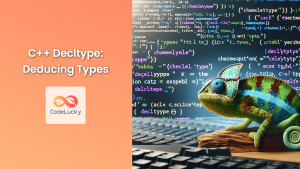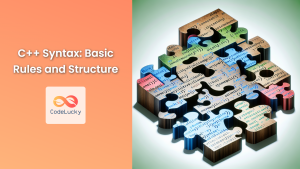In the ever-evolving landscape of C++, the auto keyword has emerged as a powerful tool for type inference, simplifying code and enhancing readability. Introduced in C++11, auto allows the compiler to automatically deduce the type of a variable based on its initializer. This feature has become increasingly popular among C++ developers, offering a more flexible and maintainable approach to variable declarations.
Understanding the Auto Keyword
The auto keyword in C++ is used for automatic type deduction. When you declare a variable with auto, the compiler infers its type from the initializer. This can significantly reduce the verbosity of your code, especially when dealing with complex types or template programming.
Let's start with a simple example:
#include <iostream>
#include <vector>
#include <string>
int main() {
auto i = 42; // int
auto f = 3.14; // double
auto s = "Hello, auto!"; // const char*
std::cout << "i: " << i << ", type: " << typeid(i).name() << std::endl;
std::cout << "f: " << f << ", type: " << typeid(f).name() << std::endl;
std::cout << "s: " << s << ", type: " << typeid(s).name() << std::endl;
return 0;
}
Output:
i: 42, type: i
f: 3.14, type: d
s: Hello, auto!, type: PKc
In this example, the compiler automatically deduces the types of i, f, and s based on their initializers. The typeid().name() function is used to print the type names, although the exact output may vary depending on the compiler.
🔍 Note: The auto keyword doesn't introduce any runtime overhead. Type deduction happens at compile-time, ensuring the same performance as explicitly typed variables.
Auto with Complex Types
One of the most significant advantages of auto is its ability to simplify declarations of complex types, such as those found in the Standard Template Library (STL).
Consider the following example using std::vector and std::string:
#include <iostream>
#include <vector>
#include <string>
int main() {
std::vector<std::string> names = {"Alice", "Bob", "Charlie"};
// Without auto
for (std::vector<std::string>::iterator it = names.begin(); it != names.end(); ++it) {
std::cout << *it << std::endl;
}
// With auto
for (auto it = names.begin(); it != names.end(); ++it) {
std::cout << *it << std::endl;
}
return 0;
}
Output:
Alice
Bob
Charlie
Alice
Bob
Charlie
The auto version of the loop is much cleaner and easier to read, while still maintaining type safety.
Auto with Function Return Types
The auto keyword can also be used with function return types, allowing the compiler to deduce the return type based on the function's return statements.
#include <iostream>
#include <string>
auto add(int a, int b) {
return a + b;
}
auto concatenate(const std::string& s1, const std::string& s2) {
return s1 + s2;
}
int main() {
auto sum = add(5, 7);
auto fullName = concatenate("John ", "Doe");
std::cout << "Sum: " << sum << ", type: " << typeid(sum).name() << std::endl;
std::cout << "Full Name: " << fullName << ", type: " << typeid(fullName).name() << std::endl;
return 0;
}
Output:
Sum: 12, type: i
Full Name: John Doe, type: NSt7__cxx1112basic_stringIcSt11char_traitsIcESaIcEEE
In this example, the compiler deduces that add returns an int and concatenate returns a std::string.
Auto and References
When using auto with references, it's important to be explicit about the reference. The auto keyword alone will not deduce a reference type.
#include <iostream>
int main() {
int x = 10;
auto y = x; // y is an int, not a reference
auto& z = x; // z is a reference to x
y = 20; // Only changes y
z = 30; // Changes x through the reference
std::cout << "x: " << x << std::endl;
std::cout << "y: " << y << std::endl;
std::cout << "z: " << z << std::endl;
return 0;
}
Output:
x: 30
y: 20
z: 30
🚀 Pro Tip: Use auto& when you want a reference, and const auto& for a const reference.
Auto and Const
The auto keyword respects const-qualifications. When initializing with a const value, auto will deduce a non-const type, while const auto will preserve the const-ness.
#include <iostream>
int main() {
const int ci = 42;
auto a = ci; // a is int
const auto b = ci; // b is const int
a = 10; // OK
// b = 10; // Error: b is const
std::cout << "a: " << a << ", type: " << typeid(a).name() << std::endl;
std::cout << "b: " << b << ", type: " << typeid(b).name() << std::endl;
return 0;
}
Output:
a: 10, type: i
b: 42, type: i
Auto in Range-Based For Loops
The auto keyword shines in range-based for loops, introduced in C++11. It allows for concise and readable iteration over containers.
#include <iostream>
#include <vector>
#include <string>
int main() {
std::vector<std::string> fruits = {"apple", "banana", "cherry"};
for (const auto& fruit : fruits) {
std::cout << fruit << std::endl;
}
return 0;
}
Output:
apple
banana
cherry
Using const auto& in the loop ensures that we're not making unnecessary copies of the strings and that we can't accidentally modify them.
Auto and Lambda Expressions
The auto keyword is particularly useful when working with lambda expressions, especially when the exact type of the lambda is complex or unimportant.
#include <iostream>
#include <vector>
#include <algorithm>
int main() {
std::vector<int> numbers = {1, 2, 3, 4, 5};
auto square = [](int n) { return n * n; };
std::transform(numbers.begin(), numbers.end(), numbers.begin(), square);
for (const auto& num : numbers) {
std::cout << num << " ";
}
std::cout << std::endl;
return 0;
}
Output:
1 4 9 16 25
Here, auto is used to declare the lambda function square, making the code more readable and maintainable.
Potential Pitfalls with Auto
While auto is a powerful feature, it's not without its potential pitfalls. Here are a few scenarios to be aware of:
1. Unintended Type Deduction
#include <iostream>
int main() {
auto x = 5; // int
auto y = 5.0; // double
std::cout << "x + y = " << x + y << std::endl;
return 0;
}
Output:
x + y = 10
In this example, x is deduced as an int, while y is a double. The addition promotes x to a double, which might not be immediately obvious.
2. Loss of const-ness with pointers
#include <iostream>
int main() {
const int* ptr = new int(10);
auto ptr2 = ptr; // ptr2 is int*, not const int*
// *ptr = 20; // Error: ptr is pointing to a const int
*ptr2 = 20; // OK: ptr2 is not const
std::cout << "*ptr: " << *ptr << std::endl;
std::cout << "*ptr2: " << *ptr2 << std::endl;
delete ptr;
return 0;
}
Output:
*ptr: 20
*ptr2: 20
Here, auto deduces ptr2 as int*, not const int*, potentially leading to unexpected behavior.
3. Proxy Objects
Some classes return proxy objects instead of references. The auto keyword can sometimes lead to unexpected behavior with these proxy objects.
#include <iostream>
#include <vector>
int main() {
std::vector<bool> v = {true, false, true};
auto first = v[0]; // std::vector<bool>::reference, not bool
v[0] = false;
std::cout << "v[0]: " << v[0] << std::endl;
std::cout << "first: " << first << std::endl;
return 0;
}
Output:
v[0]: 0
first: 1
In this case, first is not a bool, but a proxy object. Changes to v[0] don't affect first.
🛡️ Best Practice: When in doubt about the deduced type, use the decltype specifier or explicitly state the type.
Advanced Use Cases
1. Auto with Decltype
The decltype specifier can be used in conjunction with auto to deduce the exact type of an expression.
#include <iostream>
#include <vector>
template<typename T, typename U>
auto add(T t, U u) -> decltype(t + u) {
return t + u;
}
int main() {
auto result = add(5, 3.14);
std::cout << "Result: " << result << ", type: " << typeid(result).name() << std::endl;
return 0;
}
Output:
Result: 8.14, type: d
Here, decltype(t + u) ensures that the return type is exactly the type of the expression t + u.
2. Auto in Template Programming
The auto keyword can significantly simplify template programming, especially when dealing with complex types.
#include <iostream>
#include <vector>
#include <map>
template<typename Container>
void printFirstElement(const Container& c) {
if (!c.empty()) {
const auto& first = *c.begin();
std::cout << "First element: " << first << std::endl;
}
}
int main() {
std::vector<int> vec = {1, 2, 3};
std::map<std::string, int> map = {{"one", 1}, {"two", 2}};
printFirstElement(vec);
printFirstElement(map);
return 0;
}
Output:
First element: 1
First element: (one, 1)
The auto keyword allows the printFirstElement function to work with different container types without needing to know the exact type of their elements.
Performance Considerations
The use of auto does not introduce any runtime overhead. The compiler deduces the types at compile-time, resulting in the same machine code as if the types were explicitly specified.
However, auto can sometimes lead to unexpected copies being made, which could impact performance:
#include <iostream>
#include <vector>
#include <chrono>
class HeavyObject {
std::vector<int> data;
public:
HeavyObject() : data(1000000, 0) {}
};
int main() {
std::vector<HeavyObject> objects(1000);
auto start = std::chrono::high_resolution_clock::now();
for (auto obj : objects) { // Creates a copy of each object
// Do something with obj
}
auto end = std::chrono::high_resolution_clock::now();
std::chrono::duration<double> diff = end - start;
std::cout << "Time taken: " << diff.count() << " seconds" << std::endl;
return 0;
}
To avoid unnecessary copies, use references:
for (const auto& obj : objects) { // No copies made
// Do something with obj
}
⚡ Performance Tip: When iterating over containers of non-trivial objects, always use const auto& to avoid unnecessary copies.
Best Practices for Using Auto
-
Use
autowhen the type is obvious or unimportant: For example, when using thenewkeyword or with iterator declarations. -
Use
auto&for references andconst auto&for const references: This ensures you're working with references when intended. -
Be explicit when necessary: If the exact type is important for the logic of your code, consider using an explicit type declaration.
-
Use
autoin range-based for loops: This can make your code more readable and less prone to type mismatches. -
Be cautious with
autoin public interfaces: Usingautoin function signatures can make the interface less clear to users of your code. -
Use
autowith lambda expressions: This can greatly simplify code when working with complex lambda types. -
Be aware of proxy objects: In cases where proxy objects might be returned (like with
std::vector<bool>), consider usingdecltype(auto)or explicit typing.
Conclusion
The auto keyword is a powerful feature in C++ that can greatly enhance code readability and maintainability when used correctly. It simplifies complex type declarations, works well with modern C++ features like range-based for loops and lambda expressions, and can make template programming more accessible.
However, it's important to use auto judiciously. While it can make code more concise and less prone to type mismatches, it can also obscure the exact types being used, potentially leading to subtle bugs if not used carefully.
By following best practices and being aware of potential pitfalls, you can leverage the power of auto to write cleaner, more efficient C++ code. As with any powerful tool, the key is to understand its strengths and limitations, and to use it thoughtfully in your C++ programming journey.
Remember, the goal is not just to write code that works, but to write code that is clear, maintainable, and efficient. The auto keyword, when used wisely, can be a valuable ally in achieving this goal.
Happy coding! 🚀👨💻👩💻


















